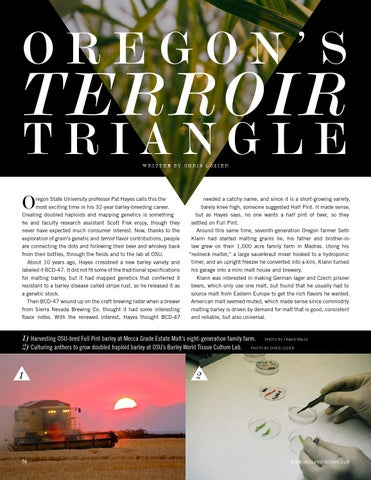OREGON’S
TERROIR
TRIANGLE WRITTEN BY CHRIS LOZIER
O
regon State University professor Pat Hayes calls this the most exciting time in his 32-year barley-breeding career. Creating doubled haploids and mapping genetics is something he and faculty research assistant Scott Fisk enjoy, though they never have expected much consumer interest. Now, thanks to the exploration of grain’s genetic and terroir flavor contributions, people are connecting the dots and following their beer and whiskey back from their bottles, through the fields and to the lab at OSU. About 10 years ago, Hayes crossbred a new barley variety and labeled it BCD-47. It did not fit some of the traditional specifications for malting barley, but it had mapped genetics that conferred it resistant to a barley disease called stripe rust, so he released it as a genetic stock. Then BCD-47 wound up on the craft brewing radar when a brewer from Sierra Nevada Brewing Co. thought it had some interesting flavor notes. With the renewed interest, Hayes thought BCD-47
needed a catchy name, and since it is a short-growing variety, barely knee high, someone suggested Half Pint. It made sense, but as Hayes says, no one wants a half pint of beer, so they settled on Full Pint. Around this same time, seventh-generation Oregon farmer Seth Klann had started malting grains he, his father and brother-inlaw grew on their 1,000 acre family farm in Madras. Using his “redneck malter,” a large sauerkraut mixer hooked to a hydroponic timer, and an upright freezer he converted into a kiln, Klann turned his garage into a mini malt house and brewery. Klann was interested in making German lager and Czech pilsner beers, which only use one malt, but found that he usually had to source malt from Eastern Europe to get the rich flavors he wanted. American malt seemed muted, which made sense since commodity malting barley is driven by demand for malt that is good, consistent and reliable, but also universal.
1) Harvesting OSU-bred Full Pint barley at Mecca Grade Estate Malt’s eight-generation family farm. PHOTO BY TRAVIS RALLS 2) Culturing anthers to grow doubled haploid barley at OSU’s Barley World Tissue Culture Lab. PHOTO BY CHRIS LOZIER
1
74
2
WWW.ART ISANSPI RI TMAG.CO M
